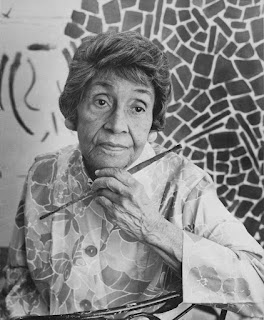Alma Thomas and Light Blue Nursery
 |
| Alma Thomas (Photo taken by Michael Fischer 1976) (Courtesy of National Museum of American Art) |
 |
| Thomas, Alma. Light Blue Nursery. 1968, Smithsonian American Art Museum. (Image from Smithsonian American Art Museum) |
Alma Thomas was born in 1891 in Columbus, Georgia. Her family moved to Washington D.C. at 1907 "to escape the racial violence in the south", according to the National Museum of Women in the Arts. When she was young, she was interested in being an architect though it was a lofty dream at the time for any woman. She attended Howard University - with one of her professors being Loïs Mailou Jones - and was the first graduate of its newly formed fine arts department in 1924. After graduation, she became an art teacher for 35 years at a junior high school in D.C. She later earned her Masters in Art Education. Although she painted throughout her teaching career, once she retired in 1960 she began to take her art more seriously. She is well known for her vibrant, colorful, mosaic-like paintings and well as her abstract watercolor pieces.
Artwork Background
The title of Light Blue Nursery has associations with nature and nursery flowers. The piece was completed in 1968. According to the Smithsonian American Art Museum, Thomas was largely inspired by the projection of light and the way light hit the trees and garden outside her home window. While light is not concretely depicted in Light Blue Nursery, the hints of lighter colors like yellow and white appear to represent this abstractly. The piece is dominated mostly by blue rows of small, mosaic-like blocks with interruptions of rows of other colors. From an abstract perspective, Light Blue Nursery mimics a garden. Thomas was a part of the Washington Color School Movement, which originated in Washington D.C. in the late 1950's. The leaders of the movement emphasized the "use of color, not drawing, to create and delineate simple geometric forms," according to the Art Story. Artists of the Washington Color School also aimed to use color to gain an immediate reaction from the viewer, with "the optical experience being more important than the subject matter" (The Art Story).
Elements and Principles of Art
So, naturally, color is the most important element of this piece. Blue is the most used color, making the painting appear serene for the most part. The reds and yellows of the painting provide some rigidity in the piece while the other colors of lilac, coral, and green add to the more calm appearance. Various shades of each color appear on the painting, which leads me to believe that this could have been partially inspired by Thomas' fascination with light. The forms of each little box cause the painting to appear to have a hand-crafted, almost pottery-like surface. Form and texture work together in this aspect to product the look of the surface, but likely not an actual feel. The painting is acrylic on canvas and seems well-blended and smooth to the point that the paint is not chunked or "caked" on the canvas (though internet pictures, try as they may, can never satisfy a in-person examination of a piece of art). Thomas has a real penchant of using these elements wisely and continuously: color, form, and line. And often, together, they contribute to her paintings appearing to have that hand-made, mosaic or pottery-like texture. Any glance at her other works immediately shows this. Below is another example of her work.
 |
| Thomas, Alma. The Eclipse. 1970, Smithsonian American Art Museum. (Image from Smithsonian American Art Museum) |
Analysis
The Washington Color School was a movement within the end of abstract art and abstract expressionism. In general, it was aligned with the movements' core ideas of color and line over subject matter. However, the pieces from the Washington Color School movement seem to be even more detached from subject matter than abstract expressionist pieces, which can be seen in Thomas' work. This could perhaps hint at the oncoming shift to Minimalism, which first began in the 1960's (see bottom of page for the Tate's summary of Minimalism). Upon my first look at Thomas' pieces, I was not immediately drawn in or fascinated by her work, likely because I tend to enjoy more subject matter in art. However, after learning more about her philosophy and reviewing more of her pieces, I became entranced with her use of color. She is an artist who, without the use of compelling or shocking subject matter, made me pause to examine, and quite frankly feel the display of artistic elements. On this blog, I have yet to encounter an artist who uses color so deliberately, but also intricately. While it may seem to be just a color piece at first glance, a closer look shows how detailed and selective she was with her use of color.
Reader Questions: How do you feel when looking at Thomas' work? Does it inspire a feeling or does it leave you wanting more content?
Other Sources:



Comments
Post a Comment